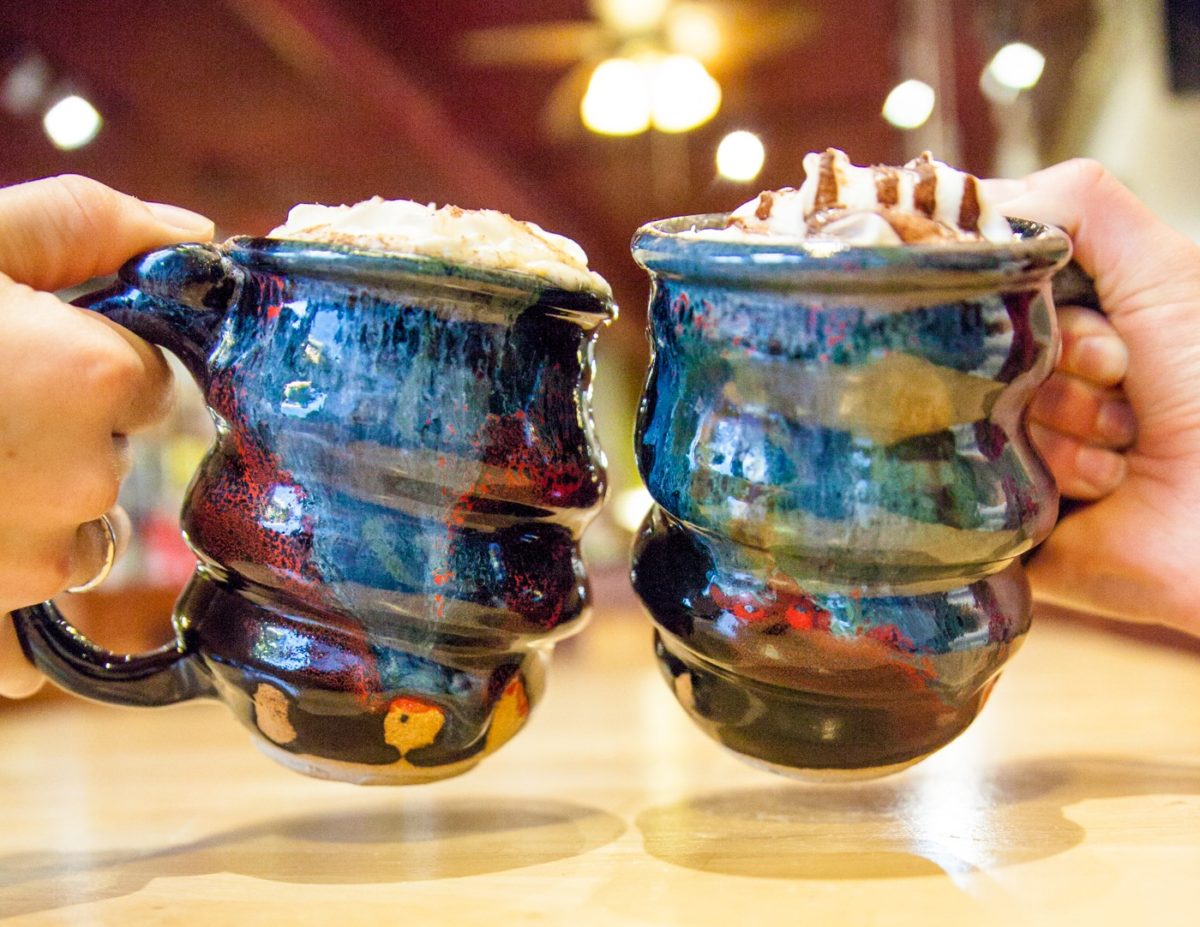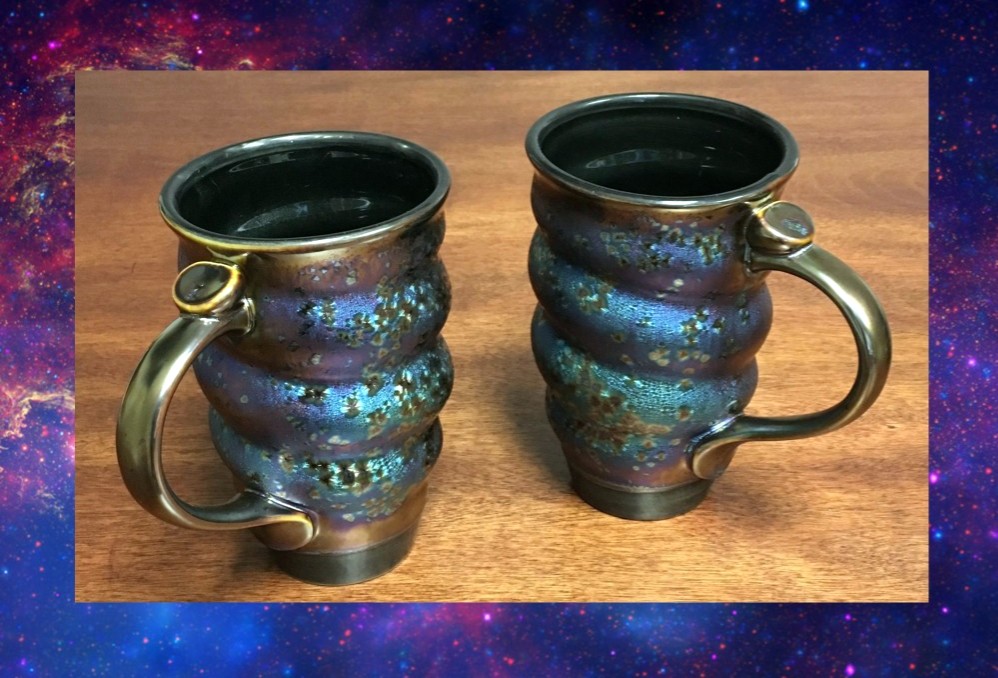(estimated reading time: 7-9 minutes)
This is a guest blog post written by Aubrey Walter, student worker at Cherrico Pottery during her undergraduate studies at the College of St. Benedict/St. John’s University. This post is a reflection of her work in the pottery office, assessing our environmental impact of shipping pottery to thousands of people globally. Enter Aubrey:
“Save what you love. A river. A mountain. A jacket. A pair of hiking boots. It all matters because it’s all connected…there is a powerful connection between treating our things as disposable and treating the people who make those things as disposable. And there is also a connection between the way we trash our stuff and the way we are trashing the planet, which is the ultimate source of all of that stuff.”
– Naomi Klein, qtd. in “Let My People Go Surfing”
People often ask us, “Is Cherrico Pottery natural?”
Yes, clay comes from the ground. Yes, Joel mixes his custom glaze recipes from natural materials, like wood ash, feldspar and silica.
But the truth is, everything comes from the ground. Even the smartphone or computer you’re using to read this was made from raw materials, which were originally mined from the earth.
How to Serve Customers and the Environment
At the time of this writing, Joel is currently throwing, glazing and firing over 500 pots per month. About 90% of those ship directly to customers’ doorsteps just weeks after he makes them.
How do we properly serve these avid pottery buyers, while still having deep respect for our environmental impact? First, we look to companies that have successfully achieved this themselves.
Every month, Joel requires each member of our team (including himself) to conduct “Reading and Research” to help us all learn the best ways to grow Cherrico Pottery, and ourselves personally. We read books, watch TED Talks, and post our quotes in the pottery office wall.
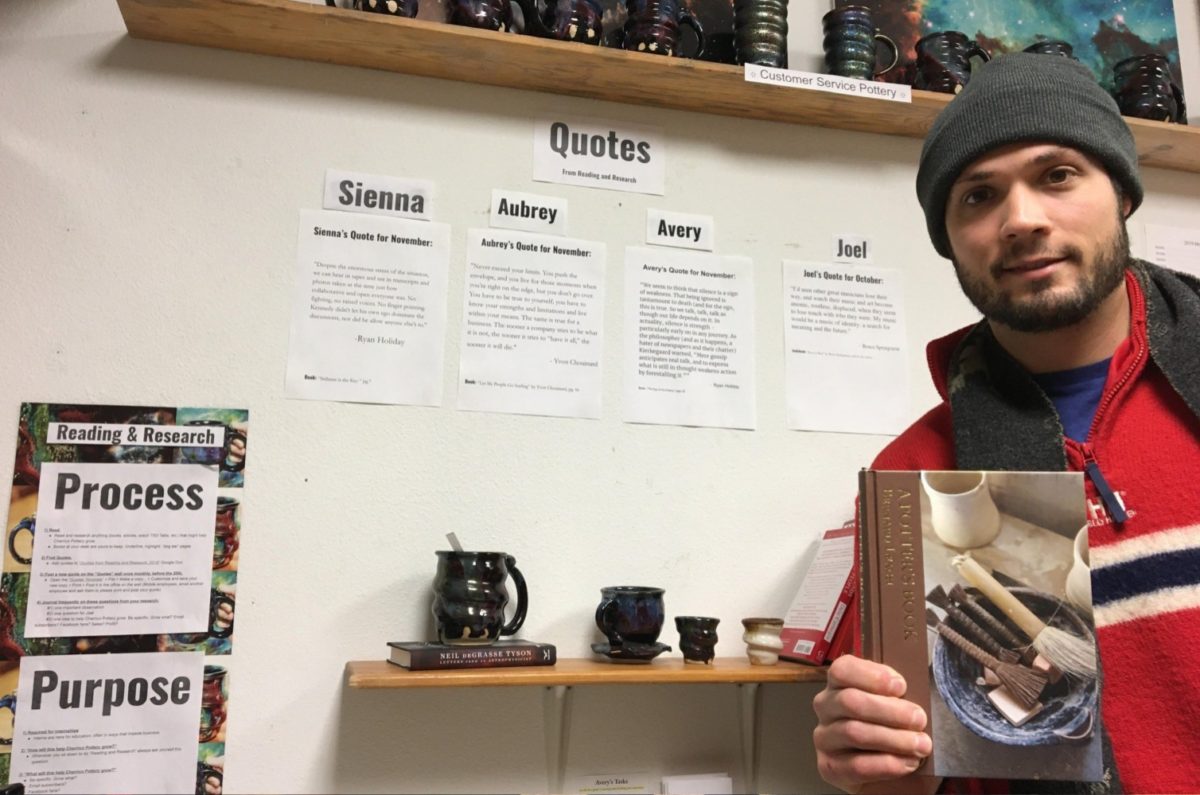
Recently, I’ve been reading Let My People Go Surfing by Yvon Chouinard, founder and CEO of Patagonia. A passionate outdoorsman, Yvon was hesitant to turn his passion into a business, weary of corporations focusing on profit and production, often destroying the very environment he grew up enjoying.
But Yvon took on this challenge with the founding of Patagonia, breaking the rules of traditional business and committing wholeheartedly to environmental responsibility.
As Yvon writes in the introduction to the book,
“Despite a near-universal consensus among scientists that we are on the brink of an environmental collapse, our society lacks the will to take action. Patagonia exists to challenge conventional wisdom and present a new style of responsible business.”
During my time as a student worker at Cherrico Pottery, I’ve seen Joel and Sienna make these same commitments to environmental responsibility.
We use 100% biodegradable packing peanuts to ensure our pottery arrives safe and sound to our customers. These peanuts are made from an organic starch that will decompose in water, leaving no toxic waste.
But not everyone wants peanuts because they make a huge mess. They’ve even been banned by Amazon because they’re so inconvenient and messy. So, we’re experimenting with our new “EA Air Cushion Machine”, which allows us to make our own bubble wrap and pillows with a #2 recyclable film.
Doing More With Less
As we said before, everything comes from the earth. Every material has pros and cons. For example, paper is a renewable resource and biodegrades, but it requires a lot more more raw materials to produce than plastic. It’s heaver to ship, less protective for our fragile pottery (requiring more material) and cutting down more trees to make more paper isn’t a great solution.
Whether using paper, plastic or biodegradable starch, the most important thing is that you make an educated decision about what to use, and how much.
This TedTalk featuring Leyla Acaroglu has given us a framework, called a “Life Cycle Assessment” to look past environmental folklore and determine how we can make the biggest positive impact.
Tracing Our Trash
Once our materials are used, where do they go?
We are also evaluating our footprint as a business by tracing each item of waste. As you can imagine in a small business that ships globally, we need to consume a lot of materials.
But even small things, like our shipping labels and packing stickers, are destined for the trash.
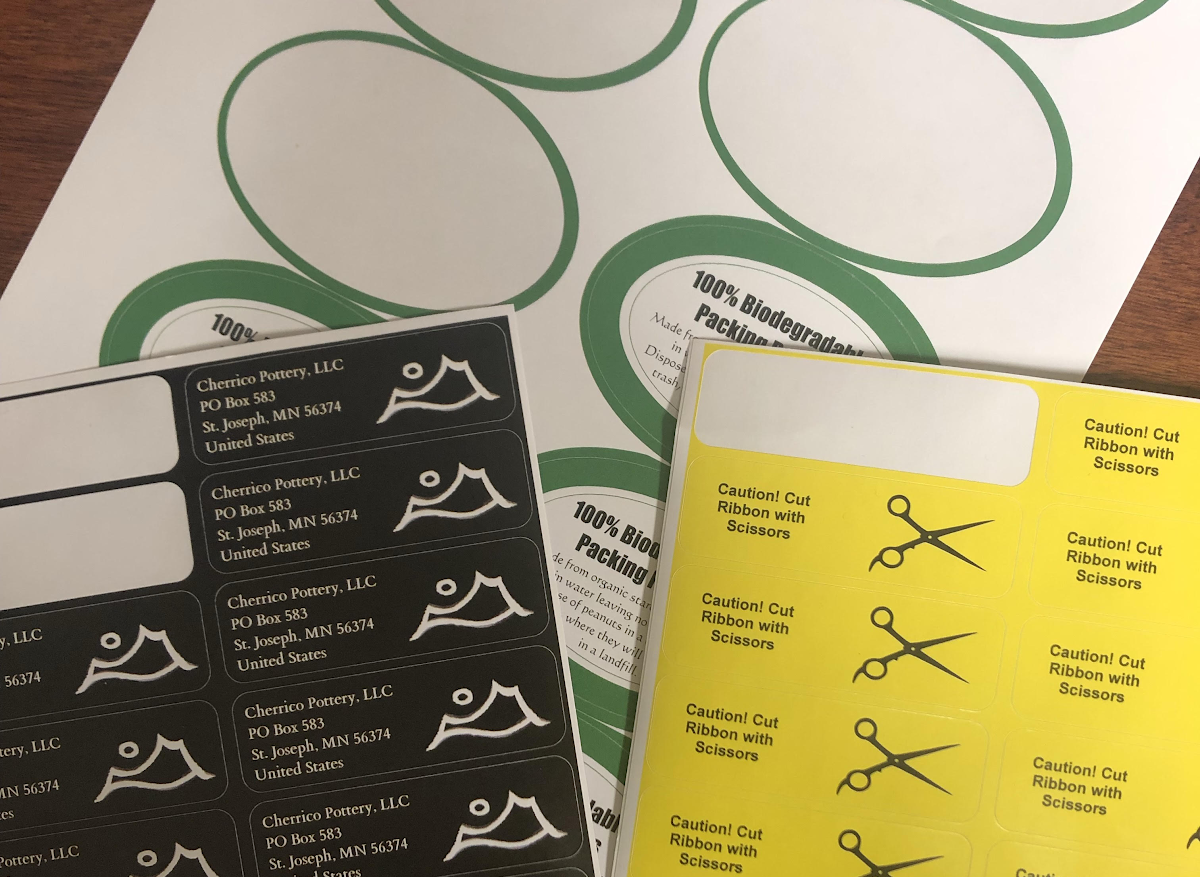
Stickers and shipping labels cannot be recycled due to their adhesive contents that get caught in recycling equipment. Their waxy backing is made of layers of both non-recyclable plastic and paper.
The thin, jute twine that we use to package our pottery is 100% recyclable and biodegradable, but it comes wrapped in protective plastic that we cannot recycle. So does the bubblewrap and cardbaord bulk boxes on full 4ft. x 4ft. pallets- all entirely wrapped in non-recyclable plastic.
Each of these items, small and large, are essential. We couldn’t fulfill thousands of pottery orders, and maintain customer satisfaction and safety, without each of these necessary pieces to our puzzle of running a sustainable business.
How do we stay environmentally conscious, while embracing global demand for Cherrico Pottery?
Odd that #EarthDay exists as a day at all. Instead, maybe it should be extended to the whole year, and then repeated annually
— Neil deGrasse Tyson (@neiltyson) April 22, 2016
Whenever we come across a new challenge, we go back to this mantra:
Even when Joel starting working with multiple Chinese factories to source a brand new type of Cosmic Mug, this mantra helped us to do it responsibly.
We call porcelain “Fine China” because the Chinese are simply the best porcelain mass-producers in the world, specifically for this type of “Tenmoku” pottery. It’s a specific type of intricate, black glazed pottery that you can learn about here, that the Chinese have been refining for 1,000 years. They can make high quantities of these mugs with both higher efficiency and quality than anyone else in the world.
After they arrive, the Cherrico Pottery Team individually inspects each mug for quality, then giftwraps them in our hand painted, recyclable cardboard boxes.
But what do we do with all the excess packing materials from China?
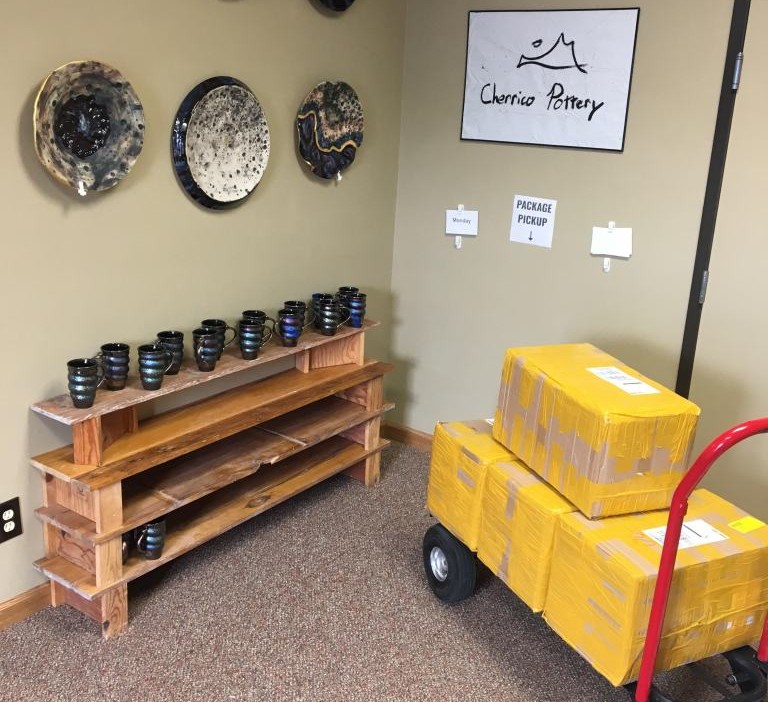
Over the years, we’ve examined and fine-tuned our process. We’ve implemented alternatives to the waste-generating and single-use aspects of our business, wherever possible.
So, instead of putting non-recyclable packing materials in the trash, Joel came up with a better solution: dunnage.
Dunnage Bags: How We Reuse Non-Recyclable Packing Materials
We now turn most all of our trash into “Dunnage Bags” to be used as packing material, instead of peanuts or air pillows. We simply put our excess, non-recyclable packing into biodegradable bags from the local co-op.
While these bags still eventually end up in the landfill, they allow us to reduce and reuse:
- Reduce our consumption of other packing materials
- Reuse these non-recyclables, instead of throwing them right into the trash
Did you know that you can reuse these bags in your own packing?
We know that our environmental footprint as a business is far from net zero, far from where it needs to be. And we recognize this. We are conscious of the waste we produce, the environmental impact our small business is having.
While many companies turn a blind eye to their waste, their emissions, their footprint, we have not. And we will not. Because the nature of our business, Cherrico Pottery, is crafted from the very minerals of the soil and the water of the seas. Pottery is an art of the earth.
Kenneth R. Beittel describes it like this in his article Zen and the Art of Pottery:
“Pottery is the humblest of man’s arts. Even before it became metaphor, pottery brought Earth to shine forth in man’s world. It is best when it is most earth-honest; that includes process-honest; fire-honest, honesty of being itself. Mere expressiveness has no depth compared with rocks and mountains, sand and sea, which speak of being and presence.”
Innately, our pottery craft requires that we be earth-honest, process-honest, fire-honest. It requires that we are conscious of our environmental choices. While many companies maintain a “business as usual” approach when it comes to environmental responsibility, we are striving to defy the norm.
Think Globally, Act Locally
There is a saying at the Local Blend Coffee Shop that serves meals everyday from Cherrico Pottery. “Think Globally, Act Locally” is their unofficial tagline. It reminds us that even the smallest act, done by anyone just within their local community, can have global impact.
We’re continuing to have conversations about our own environmental impacts here at Cherrico. How can we be more sustainable? How can we be a model of environmental responsibility for other small businesses?
We’re learning a lot about your preferences as our customers, and are continuing to look for ways to consume less.
We’d love to hear from you.
GIVEAWAY: What is one thing you do to be more environmentally friendly in your own life?
*GIVEAWAY ENDED 3/25/20. WINNERS: Jessica and kim mendez. WINNERS WERE EMAILed PRIVATELY AND NOTIFIED, AND THEIR COMMENTS WERE RESPONDED TO BELOW.
Leave a comment on this blog post before 2pm Central Wednesday, March 25th, 2020 answering the question above (What is one thing you do to be more environmentally friendly?), and we will pick two people to win two free “Random Cosmic Mugs” from our back stock, each paired with two book copies from our “Reading and Research” shelves: Let My People Go Surfing by Yvon Chouinard. We’ll mail them to two of you for free (giveaway 21+ void where prohibited, no unicorns…view more detailed giveaway policy here: cherricopottery.com/giveaway-policy) winner will be chosen by Joel Cherrico and announced in the comments one day after the giveaway ends. Please allow 24-48 hours max for our moderator to approve your comment, and winners will be announced here publicly Friday, March 27th, 2 PM or earlier 🙂